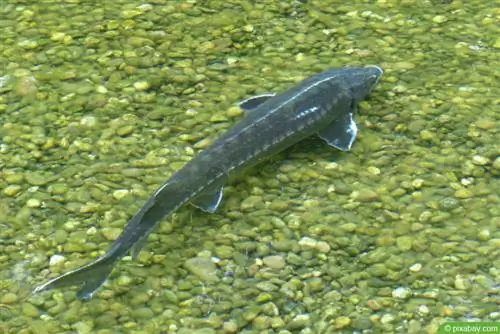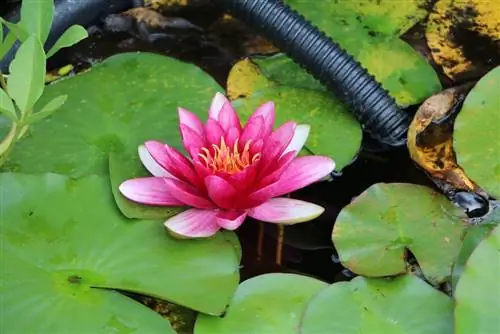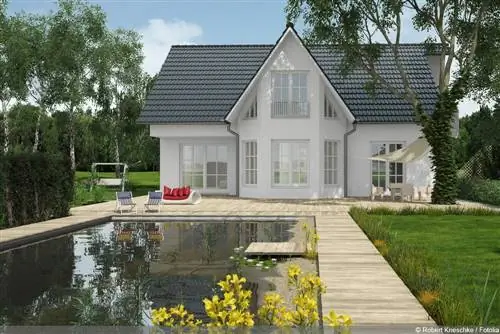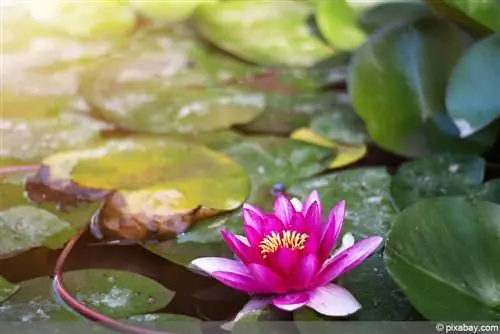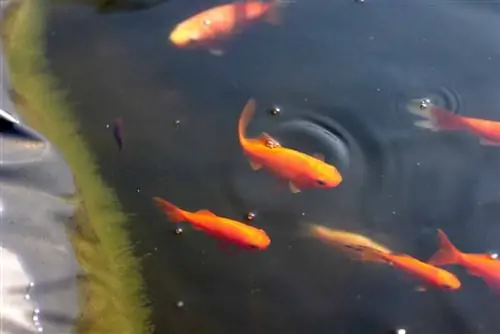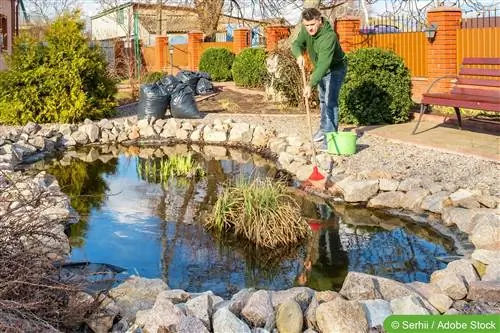- Author admin [email protected].
- Public 2023-12-17 03:39.
- Last modified 2025-01-24 12:45.
The sturgeon appears like a fossil with its horny plates, its distinctive tail fin and its long, pointed nose. It is therefore not surprising that many people would like to have it at home in their own garden pond. However, the sterlet, one of the most common representatives of sturgeon for pond keeping, is demanding. You can find out here what you should pay attention to when it comes to your posture.
Living conditions
Anyone who knows the natural living conditions of the sterlet, or its biological name Acipenser ruthenus, already has a good idea of what these demanding animals expect from their pond. For anyone who is not yet familiar with the habits of this sturgeon species, here are the key features of their habitat:
- Prefers freshwater and transition areas to brackish water in estuaries
- River waters with moderate to strong current speed
- Continuous swimmer, therefore requires a lot of space
- Foraging for food by digging in the mud or sand of the water bottom
- Tend to get entangled and die in dense vegetation
- Loves cool water temperatures of four to a maximum of 20 degrees
- Lives as an active swimmer all year round without a winter rest phase
- Lives as a flight animal, therefore avoids danger by quickly escaping the danger zone
From this ideal natural living environment of the sterlet, the minimum equipment of the pond for keeping the animals results quite easily:
- Water volume at least 30 cubic meters
- Water depth from 1.20 meters and deeper to ensure frost-free depth layer, ideally areas with more than 2.00 meters available
- Moderate to low vegetation
- Cover the pond base with sand or pond soil to enable ponding
- Flow pump for the required water flow in the pond and at the same time high oxygen content
- Good shading of the pond for moderate to low water temperatures

Since the sterlet, as a flight animal, relies on a quick escape, a pond should offer enough space, regardless of the water volume, so that the animal has the opportunity to follow its escape reflex when stressed. In the specialist literature there is always the requirement of at least twelve times the body length as an escape distance, which would mean a pond length of almost 15 meters at a relevant water depth for a fully grown animal of around 1.20 meters. Nevertheless, the available options in terms of space should be exhausted!
NOTE:
The conditions stated here represent the minimum requirements for the sterlet to live a long-term, stress-free life in the pond. However, the better the conditions, the easier it is to keep them. If individual aspects can be made more advantageous, the sturgeon will of course be happy to accept this.
Development and growth
Under favorable conditions, an adult sterlet can reach a size of up to 1.20 meters and inhabit its habitat until it is 30 to 40 years old. Breeding fish for pond keeping, on the other hand, are usually 20 to 30 centimeters long when young, so you may initially be surprised at their habitat requirements due to their small size.
At the age of three to five years, the male reaches sexual maturity with a size of around 30 to 40 centimeters, while the female needs four to seven years to reach sexual maturity and reaches a length of up to 45 centimeters.
Anyone who hopes for a large number of young sterlets in the garden pond will in most cases be disappointed. The animals, which actually migrate up the rivers as migratory fish to lay their eggs, also spawn in their feeding grounds when the water is low. However, eggs are only laid at water temperatures of 12 to 17 degrees Celsius and at a moderate flow rate on sandy or gravelly bottoms. While these requirements for reproduction in the pond can still be reproduced to some extent, the preferred water depth of at least 2 meters or more is often the exclusion criterion for the successful reproduction of this sturgeon in the garden pond.
Common attitude
Sterlets can generally be kept together with other fish species. However, you should take the following peculiarities of this fish species into account so as not to expose any of the co-resident species to unnecessary stress:
- No hibernation, therefore usually disturbing for fish species with winter rest phase
- Very slow eaters, when combining fish with common food interests, the sterlets usually succumb, resulting in emaciation and starvation
- Permanent swimmer, quickly puts fish species with a lot of time in resting phases into stress
The food
Like all sturgeon species, the sterlet feeds exclusively on animals, for example:
- Small crabs
- Shells
- Snails
- other water creatures
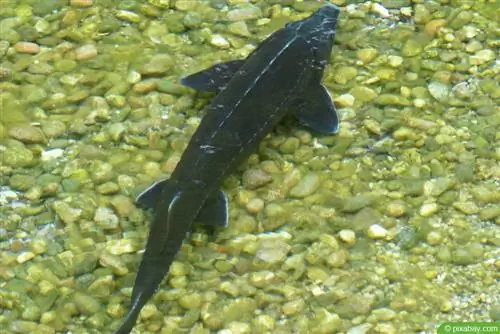
When kept in a garden pond, there is also the option of feeding high-energy sturgeon pellets, whereby crickets, mealworms and other animal feed can offer the sterlet a welcome change.
Care and diseases
Like all pond fish, the sterlet naturally suffers from various diseases. Since the treatment of possible illnesses is usually only possible through a specialist veterinarian, the pond owner's efforts should focus on generally recognizing that the animal is ill. Signs of a sick sterlet are:
- increased breathing rate
- Swimming on the surface of the water
- fin damage
- Skin changes (spots, red spots, deposits)
However, the focus of care should definitely be on maintaining favorable environmental conditions:
- high oxygen content due to functioning pump
- good water quality thanks to a functional filter, often reduced oxygen content due to oxygen consumption by bacteria and worse living conditions for sterlet
- low algae infestation, thread algae very dangerous for young animals due to entanglement and death - add algaecide if necessary
- low water temperature for optimal oxygen content and low proliferation of germs that reduce water quality
- good functionality of the flow pump to ensure the required flow
By ensuring an optimal environment, the sterlet's stress level drops significantly and the likelihood of illness decreases.

